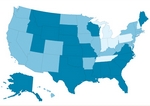Opinion
More transparency for medical student debt
■ Policies that make medical school tuition and loan practices clearer and more open can help in the fight to reduce what future physicians owe.
Posted Sept. 1, 2008.
- WITH THIS STORY:
- » Related content
When students graduate from medical school, they leave heavy with knowledge -- and heavy with debt from the loans that paid for their education.
Some of that debt burden could be lightened by knowledgeable borrowing and by greater accountability on the part of medical schools on how tuition money is spent. These were topics on the minds of both AMA delegates and lawmakers this summer.
On July 31, Congress approved reauthorization of the Higher Education Act, which contains provisions that increase transparency in college lending programs -- including medical school loans -- and puts restrictions on the relationships between lenders and college aid offices. The AMA worked alongside other groups within organized medicine to support this clause in the act, which covers federal student loan programs.
In addition, bringing greater attention to the subject, the AMA House of Delegates in June approved resolutions that contained similar language and went even further in calling on medical schools to be transparent on the crucial matter of medical school tuition.
Delegates passed one resolution, largely reflected in the reauthorization law, supporting a requirement that medical schools inform students of all government loan opportunities, as well as private loans. The resolution also supports a requirement that schools disclose why so-called preferred lenders were chosen. It called on medical schools to disclose whether they have a financial stake with a particular lender.
The AMA delegates, who were gathered for their Annual Meeting, also voted to encourage the development of policies by any school accredited by the Liaison Committee on Medical Education or the American Osteopathic Assn. to require disclosure to current and prospective students -- in a standardized format and in a timely matter -- of the allocation of funds for any tuition and fee increases.
Medical school funding is complex. But that should not stop schools from disclosing -- and being accountable for -- how they spend students' tuition money.
Students taking on 20 to 25 years of debt repayment deserve reassurance that their tuition is going for medical education -- their own and that of future physicians. Delegates expressed concern that medical school tuition was being diverted to fund other university operations.
Certainly the need for close attention to medical school debt is great and while the implications go beyond dollars and cents, the figures alone are striking. According to the Assn. of American Medical Colleges, the average educational debt of a member of the class of 2007 was $139,517, up 6.9% from that of their peers in 2006, continuing a trend of debt rising faster than the Consumer Price Index.
The AAMC reported that nearly 88% of graduating students carry outstanding loans. Slightly more than 75% of all medical students carry balances of more than $100,000.
Graduates today pay 12% to 15% of their after-tax income paying off their medical school debt -- and that percentage is growing ever higher.
Even though the reauthorization of the Higher Education Act represents some progress -- federal aid grants were expanded along with the transparency provisions -- the effort fell short. It did not address reinstatement of the 20/220 pathway, a debt-to-income ratio for economic hardship loan deferment that allows residents to better manage their debt burden. However, the 20/220 pathway is the subject of separate bills pending in the House and the Senate.
In light of the many unresolved issues in medical student debt, the AMA House of Delegates also instructed the Board of Trustees to prepare a report for next year's Annual Meeting on strategies such as competency-based curriculums that shorten the length of undergraduate education and medical school, paid rotating internships for fourth-year students who have passed initial licensing exams and have the training equivalents of midlevel providers, and pursuit of government Medicare funds for undergraduate medical education.
There is still much more to be accomplished, but for now medical students can at least make better-informed decisions about handling the debt that shapes their professional lives and also influences access to care for patients in years to come.












